European River Cruise - Part 1
Budapest to Amsterdam River Cruise “Jewels of Europe” on Scenic Amber 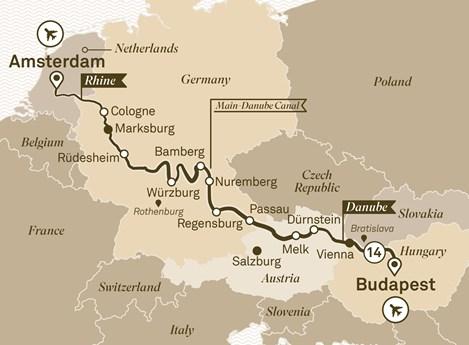
September 24 to October 13/18 - Celebrating 40th Anniversary
Monday, September 24/18 – Drove to Toronto, Lunch with Grampa, Tea with Larry and Annette and then Larry drove us to Airport to catch the 6:55 PM Air Canada Rouge flight to Budapest. Had time in the Airport Lounge and ate and drank so we could ignore the bad airplane cuisine. Overnight flight.
Tuesday, September 25/18 – Arrived in Budapest on schedule and passed through Customs and waited for our luggage and caught prearranged ride to Marriott Hotel in downtown Budapest. Fueled up at Concierge Lounge and Mary explored the city as Don rested. Mary climbed to the Liberty Monument on Buda Hill and walked on both sides of the Danube River. Back to hotel and Don came out for walk to Hungarian Parliament Buildings. Dinner in Lounge and early bedtime since missing sleep last night. 

Wednesday, September 26/18 – Mary explored more of Budapest – St Stephen’s Cathedral and walked all the way to Heroes Square and got back to the hotel for lunch. Caught the 2 PM Scenic bus to the ship – the Scenic Amber – not the Scenic Opal as booked due to low river level problems – Room 236 at back of ship. Looked around ship and had dinner. After dinner the ship cruised on the Danube in Budapest to see the sights by night. 
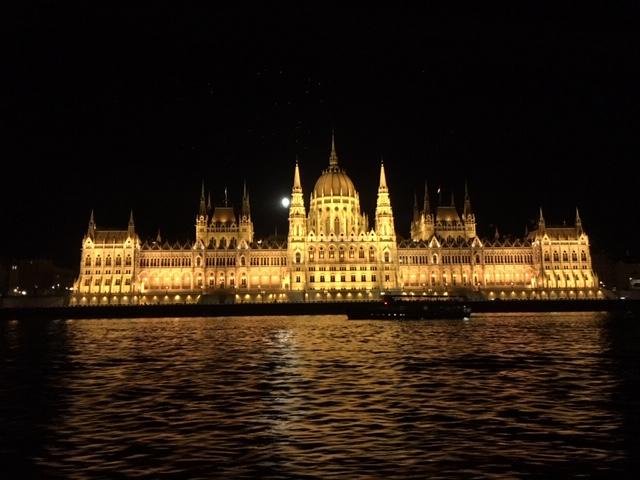
Hungarian National Museum
Thursday, September 27/18 – Budapest Tour – On Buda side we visited the St Matthias Church and Fisherman’s Fortress (Fairytale Castle with seven towers in pale stone built for city celebrations in 1896 on eastern rim of Castle Hill) and then over chain bridge to Pest side to Heroes Square – also erected for 1896 and entrance to City Park. This was followed by a piano/organ concert by the music teacher at a School for the Blind. Back to the ship for lunch and I took a walk after lunch over the bent bridge and to do a little shopping – bought Hungarian Paprika, dark chocolate and a little pottery hedgehog that is a toothpick holder. 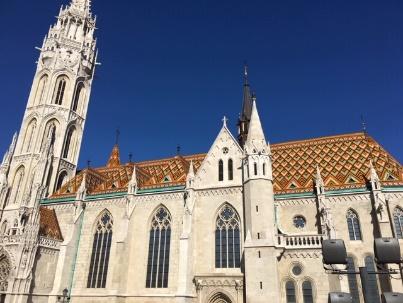


We sailed at 4:30 and had a safety drill at 5 PM and Captain’s welcome dinner that evening. We will pass through 68 locks on our way to Amsterdam.
For entertainment in the lounge there was a Hungarian Folk Show.
Passed by Esztergom in the dark – Former Royal City and birthplace of King Stephen 1 which was destroyed by the Turks in 1543 and rebuild to have Hungary’s largest Cathedral (1820s) and is 41 miles north of Budapest.
Friday, September 28/18 - After Breakfast we received a Cruise Overview talk with the Cruise Director Tadej. Our Tailor-made devices were explained and we were introduced to the e-bikes. Had Lunch and we arrived in Vienna at 4 PM. Dinner was at 5 PM and then we enjoyed a private Classical Music Concert (Strauss and Mozart)at Palais Liechtenstein in Vienna. 
Saturday, September 29/18 – Vienna – Bus to Schonbrunn Palace for morning tour. Imperial Summer Baroque Palace for the Habsbergs built in 1695 just outside of Vienna – 1441 rooms to compete with Versailles in Paris. Empress Maria Theresia built on to the palace and remodeled it as she received it as a wedding gift in the mid 1700s.
Maria Theresia and her husband, Francis 1, Holy Roman Emperor, had eleven daughters and five sons. Of the 16 children born in 20 years, 10 survived to adulthood. Marie Antionette was a daughter. Our guide said that Francis was rumoured to have 54 illegitimate children because Maria was frigid?
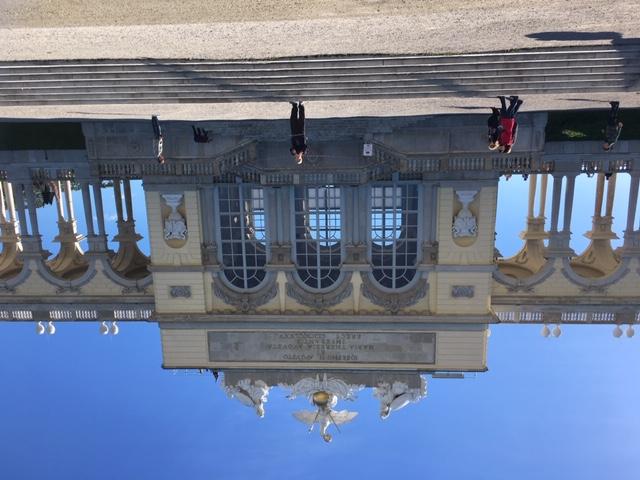

Maria Theresia and her husband, Francis 1, Holy Roman Emperor, had eleven daughters and five sons. Of the 16 children born in 20 years, 10 survived to adulthood. Marie Antionette was a daughter. Our guide said that Francis was rumoured to have 54 illegitimate children because Maria was frigid?
There is a Gloriette structure at the end of the formal gardens on a 60 metre high hill. It was built to glorify Habsburg power (ruled for over 600 years). It was destroyed in WW2 but restored in 1947 and again in 1995. Today it houses a café.
The Schonbrunn Palace is now owned by the Republic of Austria and is a UNESCO site on the World Heritage List.
On the return drive to the ship, there was an option to stop in the downtown area of Vienna to sightsee and take the shuttle service back to the ship later. Mary took advantage of this.
Exploring Vienna on this Saturday afternoon there were lots of crowds on this sunny warm day so in the 90 minutes I was there I took the elevator to the top of St Stephen the Martyr Cathedral with its black, yellow and green tiled roof and 446 foot gothic south tower. I also visited St. Peter’s Church (baroque) nearby the Cathedral and enjoyed an organ recital there. I wandered down more streets and came to the front of the Hofburg (Imperial Palace) which took 6 centuries to build and has 2600 rooms. It houses the Spanish Riding School (with the Lippazzner horses), Apartments, Empress Sisi Museum(Empress Elizabeth of Austria /Queen of Hungary).
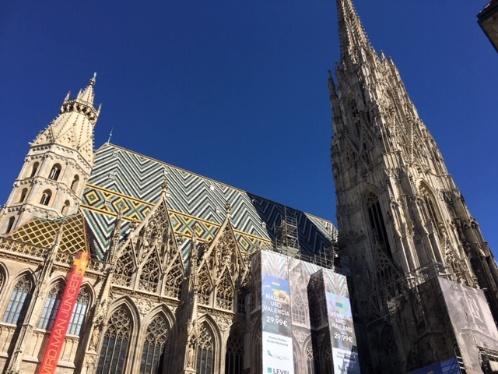
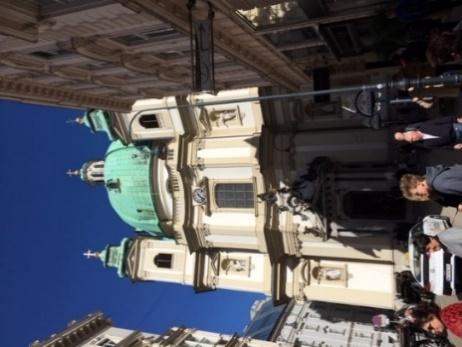
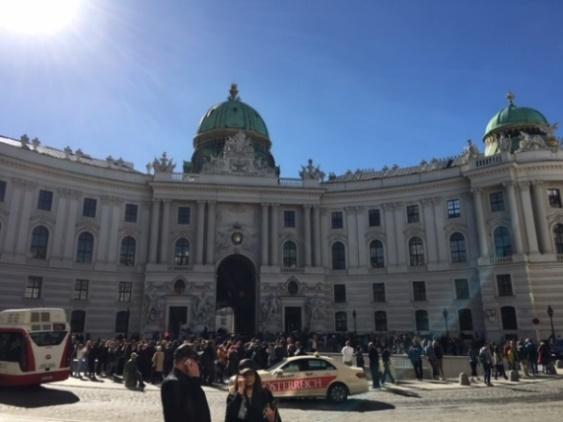

Exploring Vienna on this Saturday afternoon there were lots of crowds on this sunny warm day so in the 90 minutes I was there I took the elevator to the top of St Stephen the Martyr Cathedral with its black, yellow and green tiled roof and 446 foot gothic south tower. I also visited St. Peter’s Church (baroque) nearby the Cathedral and enjoyed an organ recital there. I wandered down more streets and came to the front of the Hofburg (Imperial Palace) which took 6 centuries to build and has 2600 rooms. It houses the Spanish Riding School (with the Lippazzner horses), Apartments, Empress Sisi Museum(Empress Elizabeth of Austria /Queen of Hungary).
But no time to tour.
Back to the ship for 3 PM and we sailed off at 10 PM for Durnstein. Rough night with our room at the end of the ship by the engines – noise and vibration.
Sunday, September 30/18 – Durnstein, Austria – Arrived at 6 AM. We had free time after breakfast to explore the small village of Durnstein. Too early for Church, I strolled to the town and climbed up the hill behind the town to the castle ruins (1000 feet above sea level). This castle is where King Richard I of England (Richard the Lionhearted) returning from the Third Crusade was imprisoned after being captured near Vienna by Duke Leopold V of Austria.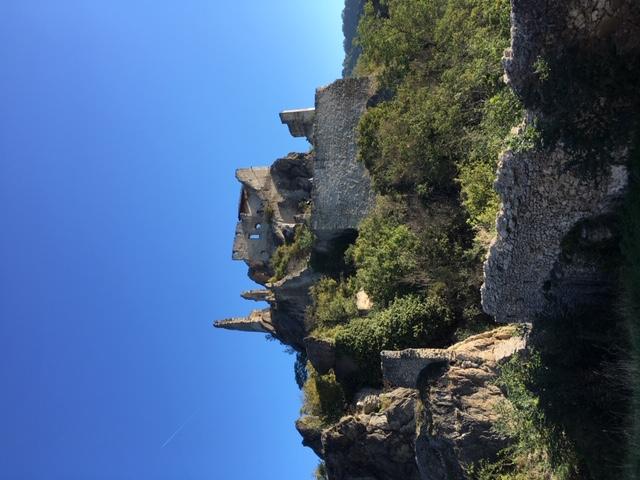
Back to the ship for 3 PM and we sailed off at 10 PM for Durnstein. Rough night with our room at the end of the ship by the engines – noise and vibration.
Sunday, September 30/18 – Durnstein, Austria – Arrived at 6 AM. We had free time after breakfast to explore the small village of Durnstein. Too early for Church, I strolled to the town and climbed up the hill behind the town to the castle ruins (1000 feet above sea level). This castle is where King Richard I of England (Richard the Lionhearted) returning from the Third Crusade was imprisoned after being captured near Vienna by Duke Leopold V of Austria.
At 10:15 AM we had a briefing on our 35 km bike ride for Durnstein to Melk along the Danube river in the beautiful Wachau Valley passing through small villages and many vineyards. The ship had electric bikes on board and a few extra were provided by the bike tour company. An American woman from Vermont who went to university in Austria and stayed to marry and have a family was our leader. About 24 passengers participated. 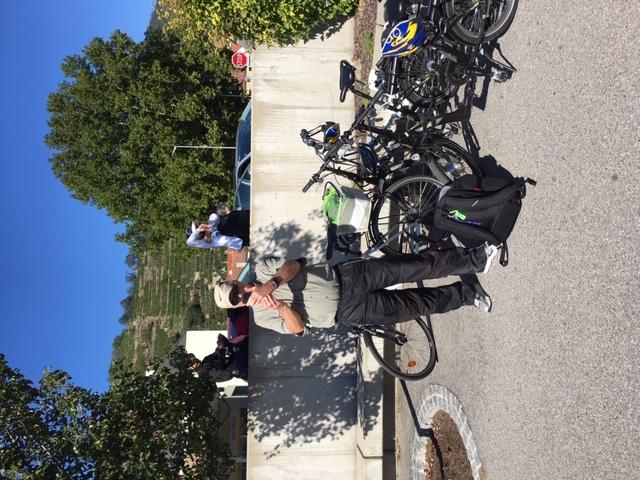

While we cycled, the ship sailed on the Danube (Donau) from Durnstein to Melk and docked and we then had lunch.The afternoon excursion was to the Melk Benedictine Abbey. (Mary) I toured through its museum, Marble Hall, 2 storey library and magnificent Baroque church.
On the Melk site, the Romans built a fortress 2000 years ago, then a castle around 950 AD for Duke Leopold III of Babenburg who later handed it over to Benedictine monks who made it into an abbey dedicated to Saint Peter and Paul. In the 1700’s the abbey was rebuild because it was badly damaged by Turkish troops. Today it is also a secondary school for about 900 students – male and female.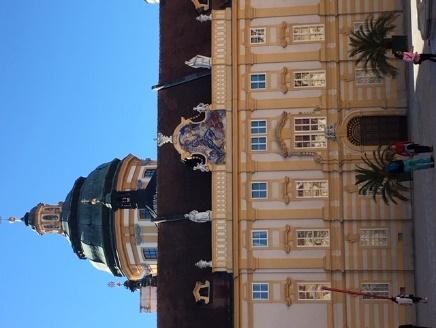
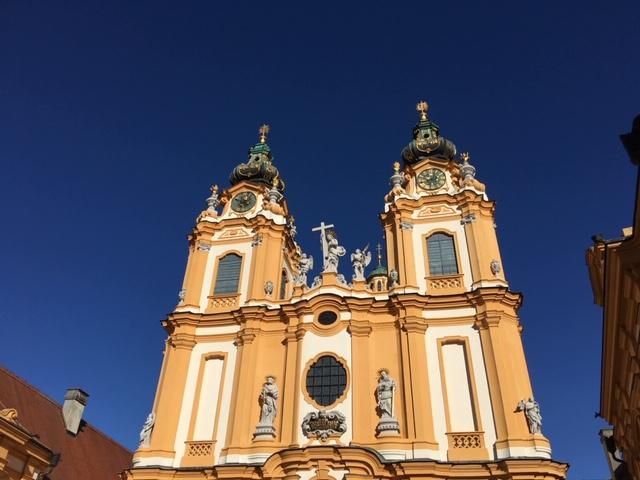
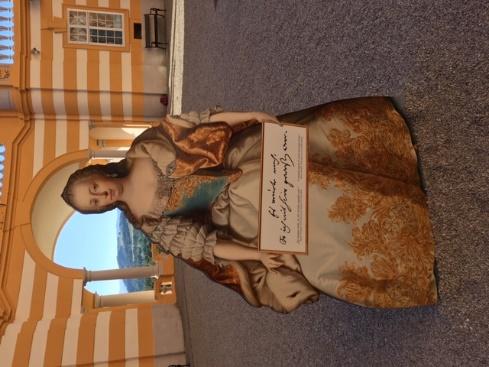
On the Melk site, the Romans built a fortress 2000 years ago, then a castle around 950 AD for Duke Leopold III of Babenburg who later handed it over to Benedictine monks who made it into an abbey dedicated to Saint Peter and Paul. In the 1700’s the abbey was rebuild because it was badly damaged by Turkish troops. Today it is also a secondary school for about 900 students – male and female.
As Empress Maria Theresia holds the sign which says – “I would regret if I had not been here.” Apparently she visited 3 times and had with her a staff of over 100.
We had a peak at the gardens but time was short as we were bussed away to a special “Sundowner” Event at Eggstein Castle. (Don and Mary)
Aggstein – Austria’s most well-known castle ruin. High above the Danube, it sits atop 2 steep rocky outcrops and is located in the heart of one of the finest river landscapes in the world: the Wachau. It has been entered in the list of UNESCO World Heritage Sites since 2000.
With its strategically favourable position, Aggstein Castle was an important fortress that belonged to various well-known Austrian noble families over the centuries. We enjoyed a glass of wine , were entertained and watched the sunset before returning to the ship for dinner.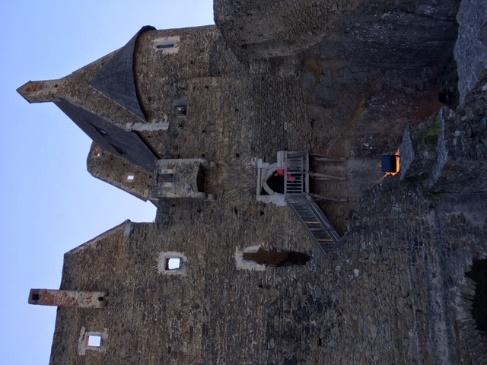
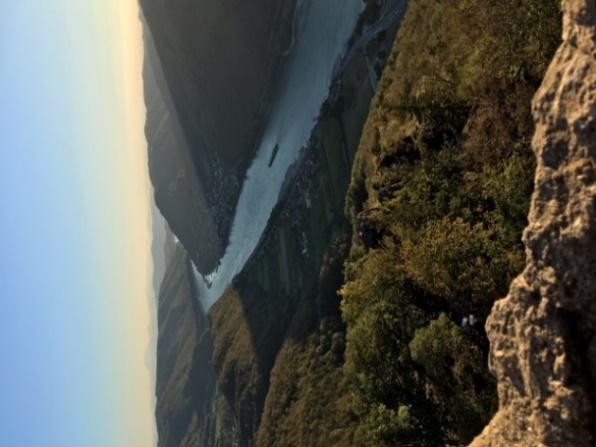
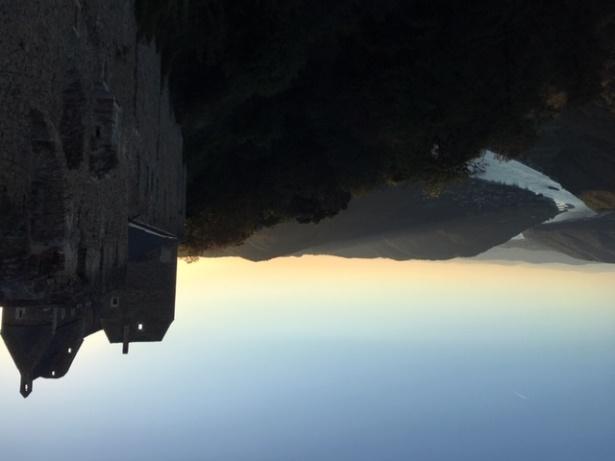
With its strategically favourable position, Aggstein Castle was an important fortress that belonged to various well-known Austrian noble families over the centuries. We enjoyed a glass of wine , were entertained and watched the sunset before returning to the ship for dinner.
Monday, October 1/18 – “Sound of Music Tour” to Salzberg (Mary). After a scenic 2 hour bus ride we arrived for old town tour of Salzberg – birthplace of Wolfgang Amadeus Mozart (1756-91). (We did learn from our tour guide on the bus that the Alps are still growing. The rivers are green due to the limestone. The Bavarian forest has granite stone. Austria has 9 million people. Austria has the Porsche – Badden factory and some BMW (Bavarian Motor Works) engines are also built in Austria.)
We walked into the old town to Mozartplatz and the site of the baroque Salzberg Cathedral (Dom) (1614 -1628). Mozart was bapised in the Dom and he was its organist while still a teenager. Mozart’s father was a musician and his sister as well. We went by Mozart’s birthplace (Geburtshaus) but did not cross a bridge to see his family’s apartment there. We passed by an open market area and famous shopping area.
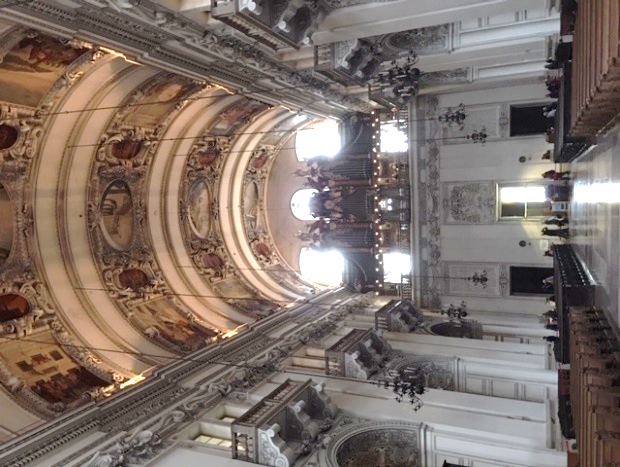

We walked into the old town to Mozartplatz and the site of the baroque Salzberg Cathedral (Dom) (1614 -1628). Mozart was bapised in the Dom and he was its organist while still a teenager. Mozart’s father was a musician and his sister as well. We went by Mozart’s birthplace (Geburtshaus) but did not cross a bridge to see his family’s apartment there. We passed by an open market area and famous shopping area.
We were given some free time and I strolled with a fellow Scenic traveller John Brown from Nova Scotia (wife Irene as still on the ship where Don was too). We visited some churches (even below to the Crypts) and wandered behind Church of St Peter to an old cemetery. We stopped into the tiny Furst Chocolate shop at Brodgasse 13, to purchase the celebrated Mozartkugein – Mozart Balls – delicious round chocolates with creamy marzipan filing. These were first created in 1890 by Paul Furst.
Then the touring groups were reassembled to stroll back to the busses to travel up the mountain to have lunch at a lovely restaurant “Zistelalm” – 1100 metres above sea level (unfortunately it was a foggy rainy day so no scenic views from up high) and enjoyed live entertainment playing and singing classical, traditional and Sound of Music songs. 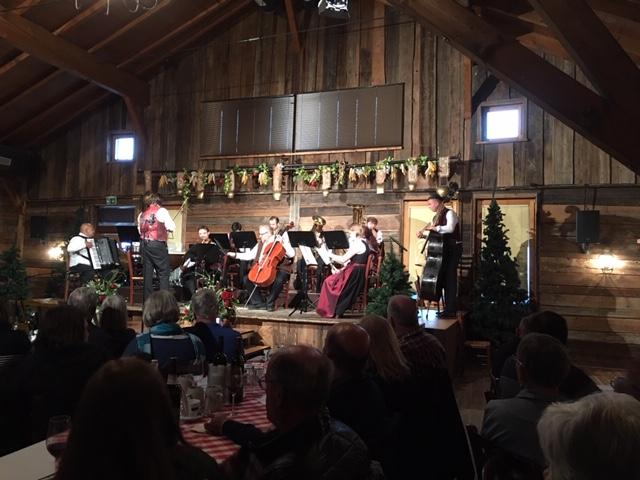
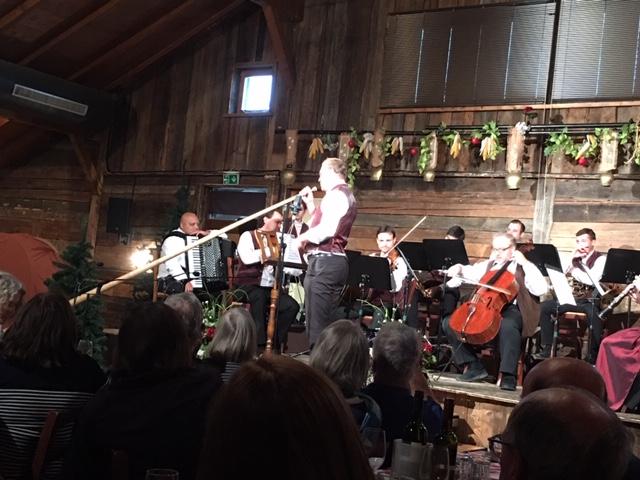
On the bus our tour leader told us many things about the “Sound Of Music:
- Captain von Trapp was in the Austrian Navy – at that time Austria had a coastline on the Mediterrean Sea (now Croatia has the coast) and he was involved with submarines and testing torpedoes. This eneavour involved the Whitehead family from the US. Von Trapp’s first wife was a Whitehead and they had 7 children. His first wife died in 1921 but that connection brought the family to the US?|
- Maria was not hired as a governess for all the children but only for one of the girls who was sickly and could not attend school.
- Captain von Trapp and Maria married in 1927 (he was 25 years older) and they had 3 children together. Apparently Maria was very strict and not as loving and kind as depicted in the movie.
- Captain von Trapp was the owner of several companies and was rich after his military career but had all his money in an Austrian bank and those banks went bankrupt in 1935.
- Then life changed and the family started their singing career for money – singing traditional Austrian Folk Songs.
- The Von Trapp family had a professional singing teacher that was not mentioned in the movie and this teacher came with them to the US.
- 1937 – Salzberg Music Festival – Captain von Trapp did not sing with the family because he was a noble so that was not acceptable in that society.
- The family was invited to sing on radio in Vienna and then went on tour in Europe.
- in 1938 Captain von Trapp was invited to Berlin by the Nazis – because of his experience with submarines but he did not report.
-The family did not climb over a mountain in Austria. Captain von Trapp was called a second time by the Nazis and did not report. They escaped to Ellis Island USA by ship after a concert in Italy.
- in 1947, Captain von Trapp died but the family continued to perfom to the mid 1950’s.
- 1959 – Broadway show of “the Sound of Music”.
- 1965 – US film “Sound of Music” made in Salzberg. The “do, ray, me” song was shot at Mirabelle Castle which was home to a mistress of the Prince- Archbishop of Salzberg.
In 1955, a European black and white film was made of the von Trapp family so the American version was not well received since it was poorly dubbed in German and different songs were substituted.
- Captain von Trapp was in the Austrian Navy – at that time Austria had a coastline on the Mediterrean Sea (now Croatia has the coast) and he was involved with submarines and testing torpedoes. This eneavour involved the Whitehead family from the US. Von Trapp’s first wife was a Whitehead and they had 7 children. His first wife died in 1921 but that connection brought the family to the US?|
- Maria was not hired as a governess for all the children but only for one of the girls who was sickly and could not attend school.
- Captain von Trapp and Maria married in 1927 (he was 25 years older) and they had 3 children together. Apparently Maria was very strict and not as loving and kind as depicted in the movie.
- Captain von Trapp was the owner of several companies and was rich after his military career but had all his money in an Austrian bank and those banks went bankrupt in 1935.
- Then life changed and the family started their singing career for money – singing traditional Austrian Folk Songs.
- The Von Trapp family had a professional singing teacher that was not mentioned in the movie and this teacher came with them to the US.
- 1937 – Salzberg Music Festival – Captain von Trapp did not sing with the family because he was a noble so that was not acceptable in that society.
- The family was invited to sing on radio in Vienna and then went on tour in Europe.
- in 1938 Captain von Trapp was invited to Berlin by the Nazis – because of his experience with submarines but he did not report.
-The family did not climb over a mountain in Austria. Captain von Trapp was called a second time by the Nazis and did not report. They escaped to Ellis Island USA by ship after a concert in Italy.
- in 1947, Captain von Trapp died but the family continued to perfom to the mid 1950’s.
- 1959 – Broadway show of “the Sound of Music”.
- 1965 – US film “Sound of Music” made in Salzberg. The “do, ray, me” song was shot at Mirabelle Castle which was home to a mistress of the Prince- Archbishop of Salzberg.
In 1955, a European black and white film was made of the von Trapp family so the American version was not well received since it was poorly dubbed in German and different songs were substituted.
We returned to the ship in time for dinner. We had a delicious dinner – at the Captain’s Table at the front of the Dining Room with Don and I, John and Irene Brown, Mike and Debbie Nichol from Regina (we bonded on the long bus ride) and Mark and Cheryl from Seattle. I dissected a Mozart Ball to share with the table at dessert time. Served by our favourite server Andi from Indonesia.
Tuesday, October 2/18 – Bavaria, Germany - Passau and Regensburg – After breakfast, Don and I loaned 2 bikes from the ship and cycled about 5 km into Passau and looked around. Passau is the city of the meeting of 3 rivers. It was the site of a Roman military base and flourishing medieval city, fires in the 16th and 17th century destroyed the city and it was rebuilt in Baroque style. I visited the Cathedral of St Stephen with its gigantic organ – 17,000 pipes and 230 registers. I also took a tour inside the Old City Hall(Rathaussaal) with it’s Baroque Council Hall (1662) and gothic staircase dating from 1446. 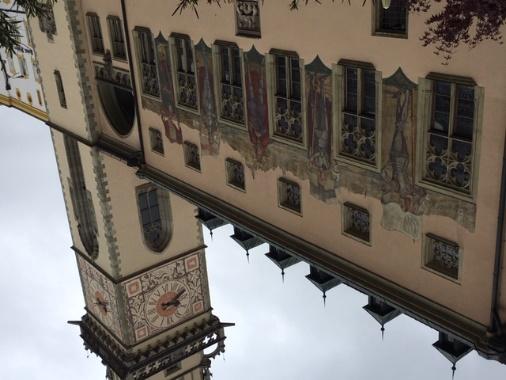
Old City Hall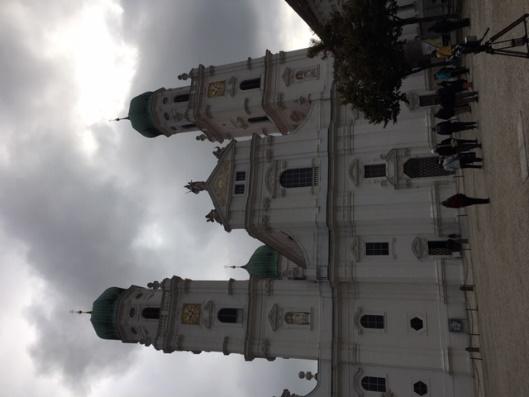

Fresco in Council Chambers of Old City Hall
Furnace unit in Council Chambers. Stoked from the back just like the ones at that time period in Palaces.
Ceiling in Council Chambers
Water Levels noted on side of Old City Hall – note level of 2013! That is a man standing beside the chart.
Back to the ship for lunch and then on a bus for a tour to Regensburg. (Mary) It is located at the northernmost point of the Danube River. A Roman city in the 2nd century, christenized in the 7th century and delared a Free Imperial City in 1245. It is a UNESCO World Heritage historical town. The city was often chosen as the venue of meetings of the German Parliament, the so-called Imperial Diet (courts) and from 1663 to 1806 it was the seat of a Permanent Diet.
On arrival, we walked across the medieval Danube Stonebridge with its 16 arches and is one of Europe’s earliest surviving bridges constructed between 1135 and 1146. Note the little spy on the pedestal.
We stopped at the historic Wurstkuchl which is the oldest sausage restaurant where the workers on the bridge and cathedral ate. We noted the Porta Praetoria – a 2nd century Roman gateway. On to Goliath Haus (Shindler family lived there for a time) and the statue of Jon Paul (story) and then Cathedral of St. Peter with its amazing stained glass windows and story to the devil and his grandmother.
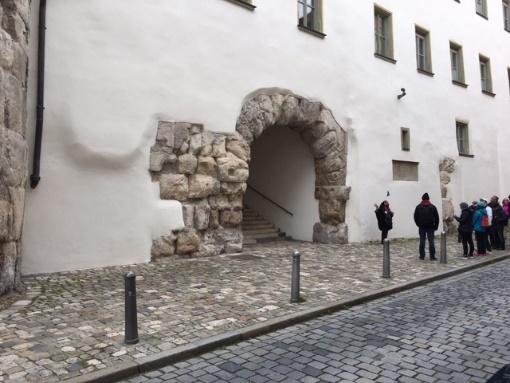

On arrival, we walked across the medieval Danube Stonebridge with its 16 arches and is one of Europe’s earliest surviving bridges constructed between 1135 and 1146. Note the little spy on the pedestal.
We stopped at the historic Wurstkuchl which is the oldest sausage restaurant where the workers on the bridge and cathedral ate. We noted the Porta Praetoria – a 2nd century Roman gateway. On to Goliath Haus (Shindler family lived there for a time) and the statue of Jon Paul (story) and then Cathedral of St. Peter with its amazing stained glass windows and story to the devil and his grandmother.
Bus ride back to Ship for dinner and night.

Comments
Post a Comment